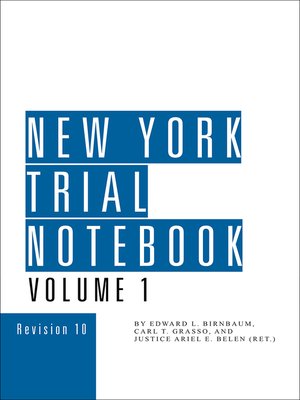
Sign up to save your library
With an OverDrive account, you can save your favorite libraries for at-a-glance information about availability. Find out more about OverDrive accounts.
Find this title in Libby, the library reading app by OverDrive.



Search for a digital library with this title
Title found at these libraries:
| Library Name | Distance |
|---|---|
| Loading... |
New York Trial Answer Book
Techniques, law, and forms for trial preparation and presentation.
The latest edition of New York Trial Notebook adds hundreds of new case citations, dozens of new tips, and many new and substantially revised sections. Turn to New York Trial Notebook for clear, concise explanations, practice tips, and recent case-based illustrations covering everything from preparing the case for trial through post trial motions.
Lawyers no longer have as many opportunities to polish their trial skills. Small cases rarely reach courtrooms, and specialists and public defenders now handle the criminal cases that used to keep civil lawyers trial-ready.
However, the procedures and cases governing New York courtrooms — and the techniques that work in them — must still be learned and remembered. Here is the solution.
Courtroom veterans Ed Birnbaum, Carl Grasso, and Justice Ariel Belen have blended their hard-won trial lessons with the law and rules governing New York trials in New York Trial Notebook. This practical work is heavily-supported with 2,000 cases containing parenthetical descriptions and pinpoint citations, more than 80 forms in print and via Digital Access, and dozens of practice tips. New York Trial Notebook delivers:
Expert witness disclosure
Eve-of-trial preparation
Expert witness testimony
Jury selection
Trial tips
Cross examination of lay witnesses







